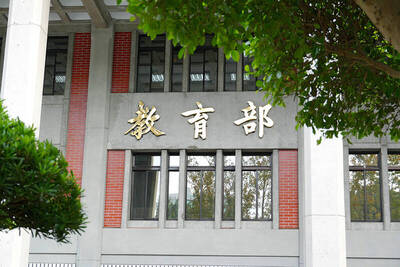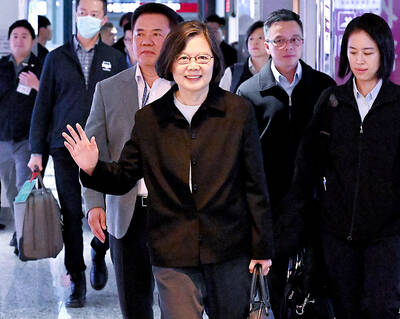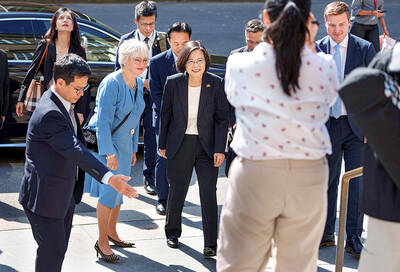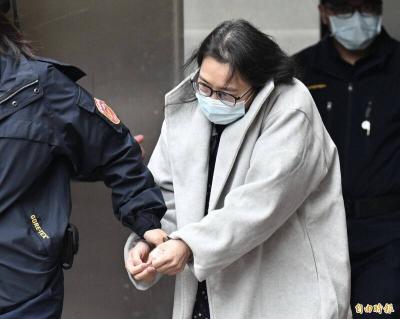With a spate of cold fronts bringing down temperatures across the country, and customers eager to wrap up against the inclement weather, garments claiming to be “thermogenic” — meaning that they generate heat — are flying off the shelves.
Unlike electric blankets that actively produce heat after being switched on, most of the so-called “thermogenic” clothes generate heat through the process of capturing moisture evaporating from the body and trapping it in their fibers, said Chiu Sheng-fu (邱勝福), a director at the Taiwan Textile Research Institute’s Department of Testing and Certification.
“However, the name ‘heat-generating clothes’ is bizarre, as the working theory of such products is based on the physical principle of moisture absorption and heat retention, making its heating effect a passive one [as opposed to an active one,]” Chiu said.
Most heat-trapping garments available in shops are able to reach a thermal limit of between 2°C and 5°C within the first 10 minutes after making contact with the wearer’s body, with the temperature gradually dropping over time.
Accordingly, products that are able to maintain a 1°C rise in body temperature after 15 minutes of wearing are considered to be of good quality.
According to experts, high- quality thermogenic clothes can be made from various textiles, ranging from cotton, wool, natural silk, polyethylene terephthalate (PET) and linen to nylon and acrylic fibers.
The warming effect of such products is determined by the water absorption rate of their constituent fabrics, Chiu said, adding that “the more moisture they absorb, the more heat they retain for the body.”
“Among commonly used textiles [for heat-trapping clothes,] wool has the highest rate of water absorption at 15 percent, followed by cotton at 8 percent, while PET is ranked bottom with only 0.4 percent,” Chiu said.
Chiu said that the theory of “far infrared heat generation” is also applied in the manufacturing of some types of heat-generating garments, in which an oxide is either embedded into the fabric or applied to its surface to help absorb far infrared rays.
Absorbed far infrared rays are then converted into heat and stored in the fibers of the fabric, helping to keep the body warm, Chiu added.
Touting the use of wool in clothing, Hsing Wen-hao (邢文灝), a professor at Chinese Cultural University’s Department of Textile Engineering, said that wool is one of the few natural materials that absorbs moisture effectively and retains warmth and can increase body temperature by up to 6°C.
“The only drawback is that it can be hard to dry once the fabric absorbs moisture,” Hsing added.
Sales figures of thermogenic clothing have steadily increased in recent years, with millions of such products flying off the shelves this winter season.
According to statistics from Taipei-based Ming Yao Department Store, heat-trapping garments sold by Japanese clothing chain Uniqlo and Far Eastern Group were big hits during the shopping mall’s 18-day anniversary sale between Nov. 15 and Dec. 2.
“Thermogenic clothes manufactured by the Far Eastern Group sold during the anniversary period accounted for as much as 60 percent of the brand’s total sales during the period,” the department store said.
Meanwhile, heat-trapping garments produced by Taiwan’s largest convenience store chain, 7-Eleven — priced between NT$359 and NT$399 — have seen sales of about 600,000 clothing items as of October, more than three times the number it sold during the same period last year.
The 7-Eleven products are famous for their use of the company’s patented technology of coffee charcoal fibers and a high percentage of Tencel fabric.
A series of similar products launched by lingerie maker Wacoal, priced between NT$980 and NT$1,300, have also outsold wool thermal undergarments by more than two times because of their relatively low prices, better warming effects and improved comfort level, said Wacoal lingerie adviser Liu Chiung-hui (劉瓊惠), who is based in the Shin Kong Mitsukoshi Department Store’s Xinyi Branch.
In light of the lucrative market for thermogenic clothing, OK Mart convenience stores also recently started selling similar products manufactured by the Far Eastern Group, whose warming effect is certified by the Swiss-based Societe Generale de Surveillance to be able to raise body temperature by 4.5°C after wearing them for six minutes.
Societe Generale de Surveillance, registered in Geneva in 1919, is a leading inspection, verification, testing and certification company.
However, customers are advised to pay close attention to the information labeled on such products, as certification criteria have not yet been established in Taiwan.
In China, only clothing that helps increase body temperature by 4°C or above, while managing to maintain a certain average temperature, can be labeled as thermogenic garments, Chiu said.
He added that Japan only certifies clothing that can raise body temperature by a certain number of degrees within a stipulated timeframe as qualified heat-generating clothes.
Chiu said Taiwan may adopt certification standards similar to those employed by China and Japan.
Taiwan Textile Federation secretary-general Justin Huang (黃偉基) said the nation could adopt certification criteria for the effects of heat-generating clothes by early next year.
While manufacturers of such products would not be ordered to send samples for testing and certification, those who pass the criteria are can apply for a certification mark to prove their products’ quality, Huang said.

The Ministry of Education (MOE) is to launch a new program to encourage international students to stay in Taiwan and explore job opportunities here after graduation, Deputy Minister of Education Yeh Ping-cheng (葉丙成) said on Friday. The government would provide full scholarships for international students to further their studies for two years in Taiwan, so those who want to pursue a master’s degree can consider applying for the program, he said. The fields included are science, technology, engineering, mathematics, semiconductors and finance, Yeh added. The program, called “Intense 2+2,” would also assist international students who completed the two years of further studies in

Former president Tsai Ing-wen (蔡英文) departed for Europe on Friday night, with planned stops in Lithuania and Denmark. Tsai arrived at Taiwan Taoyuan International Airport on Friday night, but did not speak to reporters before departing. Tsai wrote on social media later that the purpose of the trip was to reaffirm the commitment of Taiwanese to working with democratic allies to promote regional security and stability, upholding freedom and democracy, and defending their homeland. She also expressed hope that through joint efforts, Taiwan and Europe would continue to be partners building up economic resilience on the global stage. The former president was to first

Former president Tsai Ing-wen (蔡英文) on Monday called for greater cooperation between Taiwan, Lithuania and the EU to counter threats to information security, including attacks on undersea cables and other critical infrastructure. In a speech at Vilnius University in the Lithuanian capital, Tsai highlighted recent incidents in which vital undersea cables — essential for cross-border data transmission — were severed in the Taiwan Strait and the Baltic Sea over the past year. Taiwanese authorities suspect Chinese sabotage in the incidents near Taiwan’s waters, while EU leaders have said Russia is the likely culprit behind similar breaches in the Baltic. “Taiwan and our European

The Taipei District Court sentenced babysitters Liu Tsai-hsuan (劉彩萱) and Liu Jou-lin (劉若琳) to life and 18 years in prison respectively today for causing the death of a one-year-old boy in December 2023. The Taipei District Prosecutors’ Office said that Liu Tsai-hsuan was entrusted with the care of a one-year-old boy, nicknamed Kai Kai (剴剴), in August 2023 by the Child Welfare League Foundation. From Sept. 1 to Dec. 23 that year, she and her sister Liu Jou-lin allegedly committed acts of abuse against the boy, who was rushed to the hospital with severe injuries on Dec. 24, 2023, but did not